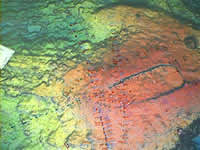| |

The topographic chart that's used to chart
the progress of the NeMO
CTD Cruise.
|
|
Teacher Logbook - R/V Wecoma
Missy
Holzer 's Sealog:
CTD Cruise Day 7
Weather at 1630 hours PDT: Overcast
skies with winds of 12 knots from the Northwest, and visibility of 4 miles.
Barometric pressure is 1024.9 mb, and the temperature is 60 degrees Fahrenheit.
Ocean swells are 4 feet out of the Northwest, and the seas are 3 feet
out of the Northwest.
It's been
a busy week on the R/V Wecoma and the NeMO CTD cruise. Our visit to Axial
volcano has kept our feet wet and instrumentation running while we gathered
more and more data about hydrothermal vents and the behavior of undersea
volcanoes. We keep track of our progress by plotting all of our mooring
locations, CTD casts, and tow-yo transects on a color-coded topographic
map of the Axial volcano region. After a week of plotting, the map is
speckled and striped with all kinds of marks.
After taking
about 24 hours to transit to our current location, the week started off
with the recovery of 5 moorings from around the Axial volcano vicinity.
Numerous strategically placed instruments that included Miniature Autonomous
Plume Recorders (MAPR's) and Miniature Temperature Recorders (MTR's) were
removed from the mooring lines that extended over 300m up the water column
from the ocean floor. A year's worth of data from the instruments will
be downloaded while at sea, and then the instruments will be set out again
on a new mooring for another year. Our quest this week also included the
acquisition of real-time data through the use of 5 tow-yo's and 14 CTD
casts in the Axial volcano region. The data from the sampled the plumes
revealed that there is still some activity from the 1998 eruption of Axial
volcano, but it has declined noticeably since that eruption.
Our work
last night came to a halt when the winch that raises and lowers the CTD
experienced an electrical short in it's motor. Of course this didn't occur
while the CTD was on the fantail of the ship, but it occurred when the
CTD was almost 1500m below the surface. The crew worked around the clock
to find the problem, resolve the problem, and get the CTD back on deck.
The resolution to the problem will be to use a different winch for the
balance of the cruise while we deploy and recover the CTD. CTD work will
resume this evening after the CTD has been hooked up to the new winch.
A busy week
it was, and in more ways than one. For those of us on board that don't
go on cruises on a regular basis, this was a week of adjusting to life
at sea: learning about sea legs, watches, what to do in our spare time,
etc. The work and life out here has almost become routine, but like with
what occurred with the winch, work and life out at sea can never really
routine. Check online tomorrow to discover what the staff and crew do
in their spare time while on board.
|

